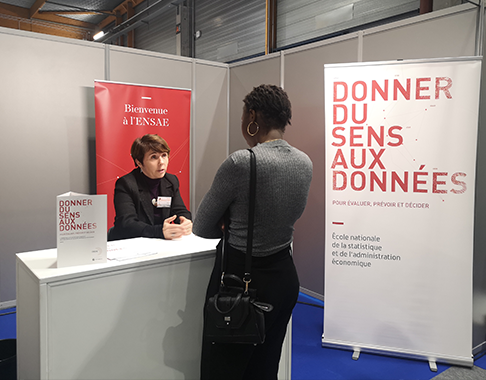Green Finance Master In Economics
Enseignant
ZERBIB Olivier David
Département : Finance
Crédits ECTS :
2
Heures de cours :
12
Heures de TD :
0
Langue :
Anglais
Modalité d'examen :
mém+sout.
Objectif
The course “Green Finance” delves into how investors can navigate environmental challenges. Specifically, it emphasizes how investors can channel financial capital to projects that bolster sustainable development and strategize around environmental financial risks. This research-oriented module presents the emerging landscape of sustainable finance, shedding light on the prevailing practices and fundamental principles of incorporating pro-environmental preferences and environmental risks into financial decisions. Specific quantitative approaches for risk and portfolio management will also be studied.
The first class (2h) will study the anthropogenic disturbances in climate change and ecosystems and their impact on financial markets. Notably, it will focus on the reason investors should care about environmental risks.
The second class (2h) will study the effect of environmental risks and preferences on asset prices and companies' cost of capital from an empirical and theoretical standpoint. Notably, it will focus on the practices of values-aligned sustainable investors.
The third class (2h) will focus on the different approaches available to investors to have a positive impact on companies’ environmental practices through their capital allocations and their engagements with firms.
The fourth class (2h) will study the assets available to investors to support the ecological transition and the way to measure their environmental footprints. It will also cover the recent regulations on disclosure and taxonomy and offer a focus on greenwashing.
The fifth class (2h) will provide background knowledge on climate risks: we will review the basic models and data sources, discuss the damage assessment methods and the scenario approach.
The sixth class (2h) will focus on the financial impacts of climate risks: we will quantify the associated uncertainties and propagation of transition risks to asset prices and briefly discuss the design of climate stress tests, the impact of climate risks on the financial stability and the role of central banks.
Plan
Course 1 (Olivier David Zerbib, 2h): Why should finance care about the environment? What are the impact of environmental risks on financial markets?
This course will study the anthropogenic disturbances in climate change and ecosystems and their impact on financial markets. Notably, it will focus on the reason investors should care about environmental risks.
The articles studied will be:
§ Galaz, V., Crona, B., Dauriach, A., Scholtens, B., and Steffen, W. (2018), Finance and the Earth system – Exploring the links between financial actors and non-linear changes in the climate system, Global Environmental Change, 296-302.
§ Krüger, P. (2015), Corporate goodness and shareholder wealth, Journal of Financial Economics 115, 304–329.
§ Riedl, Arno, and Paul Smeets (2017), Why do investors hold socially responsible mutual funds?, Journal of Finance 72, 2505-2550.
§ Scholtens, B. (2017), Why finance should care about ecology? (2017), Trends in Ecology and Evolution, 32 (7), 500-505.
Course 2 (Olivier David Zerbib, 2h): Sustainable asset pricing and values-aligned investors.
In this course, we will study the effect of environmental risks and preferences on asset prices and companies' cost of capital from an empirical and theoretical standpoint. Notably, we will focus on the practices of values-aligned sustainable investors.
The main articles studied will be:
§ Andersson, M., Bolton, P., Samama, F. (2016), Hedging Climate Risk, Financial Analyst Journal 72 (3), 13-32.
§ Chava, S. (2014), Environmental externalities and cost of capital, Management Science 60, 2223–2247.
§ Hong, H. and Kacperczyk, M. (2009), The price of sin: the effects of social norms on markets, Journal of Financial Economics 93, 15–36.
§ Pastor, L., Stambaugh, R. F., and Taylor, L. A. (2021), Sustainable investing in equilibrium, Journal of Financial Economics 142, 550–571.
§ Pastor, L., Stambaugh, R., and Taylor, L. (2022), Dissecting Green Returns, Journal of Financial Economics, 146, 403-424.
§ Zerbib, Olivier David (2021), A Sustainable Capital Asset Pricing Model (S-CAPM): evidence from green investing and sin stock exclusion, Review of Finance 27 (6), 1345-1388.
Course 3 (Olivier David Zerbib, 2h): Impact investing
This course will focus on the different approaches available to investors to have a positive impact on companies’ environmental practices through their capital allocations and their engagements with firms.
The articles studied will be:
§ Broccardo, E., Hart, O., and Zingales, L. (2022), Exit vs. Voice, unpublished working paper, Journal of Political Economy, 130(12), 3101-3145.
§ De Angelis, T., Tankov, P., and Zerbib, O. D. (2022), Climate Impact Investing, Management Science 69 (12), 7669-7692.
§ Dimson, E., Karakas, O., and Li, X. (2015), Active Ownership, Review of Financial Studies 18 (12), 3225–3268.
§ Green, D. and Roth, B. (2021), The Allocation of Socially Responsible Capital, Working Paper.
§ Hartzmark, Samuel and Kelly Shue (2023), Counterproductive sustainable investing: The impact elasticity of brown and green firms, Working Paper.
§ Heeb, Florian, and Julian Kölbel, Falko Paetzold, Stefan Zeisberger (2023), Do Investors Care about Impact?, Review of Financial Studies 36 (5):1737–1787.
Course 4 (Olivier David Zerbib, 2h): Green assets, securities’ environmental footprints, regulations and greenwashing
In this course, we will study the assets available to investors to support the ecological transition and the way to measure their environmental footprints. We will also cover the recent regulations on disclosure and taxonomy and close this course with a focus on greenwashing.
The articles studied will be:
§ Flammer, C. (2021), Corporate Green Bonds, Journal of Financial Economics 142 (2), 499-516.
§ Cartellier, F., Tankov, P., and Zerbib, O. D. (2023), Can investors curb greenwashing? Working Paper.
§ Zerbib, Olivier David (2019), The effect of pro-environmental preferences on bond prices: Evidence from green bonds, Journal of Banking and Finance 98, 39-60.
Course 5 (Peter Tankov, 2h): Climate risks: the basics
This class will provide background knowledge on climate risks. After defining physical and transition risks, we will discuss the modeling approaches to quantify them: after a brief overview of the climate models and the associated data sources, we will discuss the intergratement assessment models, which allow to produce scenarios of joint dynamics of economy and climate. Economic damage assessment will also be discussed.
References:
§ Hourcade, J.-C., F. Ghersi, R. Grandjean, J. Lefèvre, P. Tankov and S. Voisin. Climate-economic scenarios and models: a reading guide for sustainable finance, Institut Louis Bachelier, Opinions & Débats collection, 2021.
§ Pindyck, R. S. (2017). The use and misuse of models for climate policy. Review of Environmental Economics and Policy, 11(1).
§ Nordhaus, W. D. (2017), Revisiting the social cost of carbon, PNAS 114(7), 1518-1523.
§ Cai, Y., and Lontzek, T. S. (2019). The social cost of carbon with economic and climate risks. Journal of Political Economy, 127(6), 2684-2734.
§ Bovari, E., Giraud, G., and Mc Isaac, F. (2018). Coping with collapse: a stock-flow consistent monetary macrodynamics of global warming. Ecological Economics, 147, 383-398.
§ M. Kalkuhl and L. Wenz, The impact of climate conditions on economic production. evi- dence from a global panel of regions, Journal of Environmental Economics and Management, 103 (2020), p. 102360.
Course 6 (Peter Tankov, 2h): Climate risks: economic and financial impacts.
In this course we will focus on the financial and economic impacts of physical and transition risks. A special focus will be on the methods to quantify the associated uncertainties and propagation of transition risks to asset prices. We will briefly discuss the design of climate stress tests, the impact of climate risks on the financial stability and the role of central banks.
References:
§ Campiglio, E., Daumas, L., Monnin, P., & von Jagow, A. (2023). Climate?related risks in financial assets. Journal of Economic Surveys, 37(3), 950-992.
§ Flora, M. and P. Tankov, Green Investment and Asset Stranding Under Transition Scenario Uncertainty, Energy Economics, 2023.
§ Semieniuk, G., Campiglio, E., Mercure, J. F., Volz, U., & Edwards, N. R. (2021). Low?carbon transition risks for finance. Wiley Interdisciplinary Reviews: Climate Change, 12(1).
§ Barnett, M., Brock, W., and Hansen, L. P. (2020). Pricing uncertainty induced by climate change. The Review of Financial Studies, 33(3), 1024-1066.
§ S. Battiston, A. Mandel, I. Monasterolo, F. Schu ?tze, and G. Visentin, A climate stress-test of the financial system, Nature Climate Change, 7 (2017), pp. 283–288.
§ Cahen-Fourot, L., Campiglio, E., Godin, A., Kemp-Benedict, E., & Trsek, S. (2021). Capital stranding cascades: The impact of decarbonisation on productive asset utilisation. Energy Economics, 103, 105581.
Références
Andersson, M., Bolton, P., Samama, F. (2016), Hedging Climate Risk, Financial Analyst Journal 72 (3), 13-32.
Ardia, D., Bluteau, K., Boudt, K., and Inghelbrecht, K. (2022), Climate change concerns and the performance of green versus brown stocks, Management Science.
Avramov, Doron, Si Cheng, Abraham Lioui, and Andrea Tarelli (2022), Sustainable investing with ESG rating uncertainty, Journal of Financial Economics 145 (2), 642-664.
Barnett, Michael, William Brock, and Lars Peter Hansen (2020), Pricing uncertainty induced by climate change, Review of Financial Studies 33, 1024-1066.S.
Battiston, A. Mandel, I. Monasterolo, F. Schu ?tze, and G. Visentin, A climate stress-test of the financial system, Nature Climate Change, 7 (2017), pp. 283–288.
Berg, F., Koëlbel, J. F., and Rigobon, R. (2022), Aggregate Confusion: The Divergence of ESG Ratings, Review of Finance.
Berk, Jonathan B., and Jules H. van Binsbergen (2021), The impact of impact investing, Working Paper.
Bolton, P. and Kacperczyk, M. (forthcoming), Global Pricing of Carbon-Transition Risk, Journal of Finance.
Bolton, P. and Kacperczyk, M. T. (2021), Do investors care about carbon risk?, Journal of Financial Economics 142, 517–549.
Bovari, E., Giraud, G., and Mc Isaac, F. (2018). Coping with collapse: a stock-flow consistent monetary macrodynamics of global warming. Ecological Economics, 147, 383-398.
Broccardo, E., Hart, O., and Zingales, L. (2022), Exit vs. Voice, unpublished working paper, Journal of Political Economy, 130(12), 3101-3145.
Cahen-Fourot, L., Campiglio, E., Godin, A., Kemp-Benedict, E., & Trsek, S. (2021). Capital stranding cascades: The impact of decarbonisation on productive asset utilisation. Energy Economics, 103, 105581.
Cai, Y., and Lontzek, T. S. (2019). The social cost of carbon with economic and climate risks. Journal of Political Economy, 127(6), 2684-2734.
Campiglio, E., Daumas, L., Monnin, P., & von Jagow, A. (2023). Climate?related risks in financial assets. Journal of Economic Surveys, 37(3), 950-992.
Cartellier, F., Tankov, P., and Zerbib, O. D. (2023), Can investors curb greenwashing? Working Paper.
Chava, S. (2014), Environmental externalities and cost of capital, Management Science 60, 2223–2247.
Coqueret, G., Giroux, T., and Zerbib, O. D. (2024), The Biodiversity Premium. Working Paper.
De Angelis, T., Tankov, P., and Zerbib, O. D. (2022), Climate Impact Investing, Management Science 69 (12), 7669-7692.
Dimson, E., Karakas, O., and Li, X. (2015), Active Ownership, Review of Financial Studies 18 (12), 3225–3268.
Flammer, C. (2021), Corporate Green Bonds, Journal of Financial Economics 142 (2), 499-516.
Flora, M. and P. Tankov, Green Investment and Asset Stranding Under Transition Scenario Uncertainty, Energy Economics, 2023.
Galaz, V., Crona, B., Dauriach, A., Scholtens, B., and Steffen, W. (2018), Finance and the Earth system – Exploring the links between financial actors and non-linear changes in the climate system, Global Environmental Change, 296-302.
Green, D. and Roth, B. (2021), The Allocation of Socially Responsible Capital, Working Paper.
Hartzmark, Samuel and Kelly Shue (2023), Counterproductive sustainable investing: The impact elasticity of brown and green firms, Working Paper.
Heeb, Florian, and Julian Kölbel (2020), The investor's guide to impact, Technical report, University of Zurich, Center for Sustainable Finance & Private Wealth.
Heeb, Florian, and Julian Kölbel, Falko Paetzold, Stefan Zeisberger (2023), Do Investors Care about Impact?, Review of Financial Studies 36 (5):1737–1787.
Heinkel, R., Kraus, A., and Zechner, J. (2001), The effect of green investment on corporate behaviour, Journal of Financial and Quantitative Analysis 36, 377–389.
Hong, H. and Kacperczyk, M. (2009), The price of sin: the effects of social norms on markets, Journal of Financial Economics 93, 15–36.
Hourcade, J.-C., F. Ghersi, R. Grandjean, J. Lefèvre, P. Tankov and S. Voisin. Climate-economic scenarios and models: a reading guide for sustainable finance, Institut Louis Bachelier, Opinions & Débats collection, 2021.
Hsu, P.-H., Li, K., and Tsou, C.-Y. (2023), The pollution premium, Journal of Finance, 78 (3), 1343-1392.
In, S., Park, K., and Monk, A. (2019), Is ’being green’ rewarded in the market?: An empirical investigation of decarbonization and stock returns, Working Paper.
M. Kalkuhl and L. Wenz, The impact of climate conditions on economic production. evi- dence from a global panel of regions, Journal of Environmental Economics and Management, 103 (2020), p. 102360.
Kölbel, Julian and Adrien-Paul Lambillon (2022), Who pays for sustainability? An analysis of sustainability-linked bonds, Working Paper.
Krüger, P. (2015), Corporate goodness and shareholder wealth, Journal of Financial Economics 115, 304–329.
Krüger, Philipp, Zacharias Sautner, and Laura Starks (2020), The importance of climate risk for institutional investors, Review of Financial Studies, 33, 1067-1111.
Nordhaus, W. D. (2017), Revisiting the social cost of carbon, PNAS 114(7), 1518-1523.
Oehmke, M. and Opp, M. (2023), A Theory of Socially Responsible Investment, Working Paper.
Pastor, L., Stambaugh, R., and Taylor, L. (2022), Dissecting Green Returns, Journal of Financial Economics, 146, 403-424.
Pastor, L., Stambaugh, R. F., and Taylor, L. A. (2021), Sustainable investing in equilibrium, Journal of Financial Economics 142, 550–571.
Pedersen, L. H., Fitzgibbons, S., and Pomorski, L. (2021), Responsible investing: The ESG efficient frontier, Journal of Financial Economics 142, 572–597.
Pindyck, R. S. (2017). The use and misuse of models for climate policy. Review of Environmental Economics and Policy, 11(1).
Riedl, Arno, and Paul Smeets (2017), Why do investors hold socially responsible mutual funds?, Journal of Finance 72, 2505-2550.
Sato, Misato, Glen Gostlow, Catherine Higham, Joana Setzer and Frank Venmans (2023), Impacts of climate litigation on firm value, Grantham Research Institute Working Paper.
Sauzet, M. and Zerbib, O. D. (2024), When Green Investors Are Green Consumers, Working Paper.
Sauzet, M. and Zerbib, O. D. (2024), Green Intermediary Asset Pricing, Working Paper.
Sautner, Z., van Lent, L., Vilkov, G., and Zhang, R. (2023), Firm-level Climate Change Exposure, Journal of Finance, 78 (3), 1449-1498.
Scholtens, B. (2017), Why finance should care about ecology? (2017), Trends in Ecology and Evolution, 32 (7), 500-505.
Semieniuk, G., Campiglio, E., Mercure, J. F., Volz, U., & Edwards, N. R. (2021). Low?carbon transition risks for finance. Wiley Interdisciplinary Reviews: Climate Change, 12(1).
Zerbib, Olivier David (2019), The effect of pro-environmental preferences on bond prices: Evidence from green bonds, Journal of Banking and Finance 98, 39-60.
Zerbib, Olivier David (2021), A Sustainable Capital Asset Pricing Model (S-CAPM): evidence from green investing and sin stock exclusion, Review of Finance 27 (6), 1345-1388.










